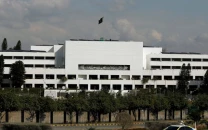Deforestation fuels flood risks
Punjab's forest cover far below global standards, according to environmentalists

The recent devastating floods in Punjab have reignited the debate over the province's meagre forest cover, with experts warning that it has amplified the scale of destruction.
Environmentalists note that forests play a vital role in absorbing rainwater, slowing down runoff and preventing soil erosion.
Punjab's forest cover stands far below global standards.
According to the United Nations benchmarks, at least 25 per cent of a country's land should be under forest cover, while in Punjab only 3.1% land is categorised as forested.
The Punjab Forest Department states that the province has a total forest area of 1.663 million acres, dominated by scrub forests (41%), while private farmlands contribute 27% through plantation. The rest includes riverine areas, rangelands and coniferous patches.
Provincial Forest Department Director General Azfar Zia said large-scale plantation drives were under way with 51 million saplings planned to be planted on 40,000 acres.
The target for the ongoing monsoon season is 21 million saplings over 25,000 acres, with 6.5 million already planted.
"In the spring plantation campaign, we exceeded the target by planting more than 10.5 million saplings," Zia added, noting that agroforestry initiatives are also engaging farmers to plant trees on their lands.
Official record shows that Punjab's forest area has grown from around 701,000 acres in 2013 to 1.263 million acres, while barren land has dropped from 960,000 acres to 399,000 acres.
However, experts argue that the progress remains insufficient. They point out that raising forest cover by even 1% would require around 43 new forests the size of Changa Manga, land for which the province does not have available.
The National Project Director at the International Union for Conservation of Nature (IUCN), Asim Jamal, said that of Punjab's forested land, only 0.45% is actually tree-covered.
He stressed that reforestation of the land was crucial. "Farmers and landowners must be convinced that trees enhance soil fertility, protect crops from disasters, and can even generate income through carbon markets," he added.
According to the World Wide Fund for Nature-Pakistan (WWF-Pakistan), the country loses about 11,000 hectares of forest every year. The main drivers include unchecked logging, wildfires, climate change and conversion of forest land for agriculture and commercial use.
WWF-Pakistan Director General Hammad Naqi Khan said, "Forest protection is not just an environmental necessity, it is an economic imperative."
He warned that large-scale felling of mature trees is compounding ecological losses, while shrinking green spaces in cities are intensifying urban flooding.
He called for stronger protection of mature trees alongside afforestation and urban greening measures.
The forest department says it is deploying modern technology for monitoring and protection. Satellite-based GIS monitoring now covers 67% of Punjab's forest area, while AI-powered drones are used for wildfire surveillance. In 2024, 269 forest fire incidents damaged 6,500 acres, but in 2025, the number of cases dropped to 200 with damage reduced to 2,500 acres.
Provincial Senior Minister Mariyyum Aurangzeb said Chief Minister Maryam Nawaz has, for the first time, banned the traditional auction system of forest timber.
The new policy aims to curb illegal logging through transparent, technology-based monitoring and mapping. The government insists that the move is not only crucial for tree protection but also vital for reducing soil erosion.
Experts, however, emphasize that large-scale afforestation in Punjab is constrained by land scarcity.



















COMMENTS (1)
Comments are moderated and generally will be posted if they are on-topic and not abusive.
For more information, please see our Comments FAQ